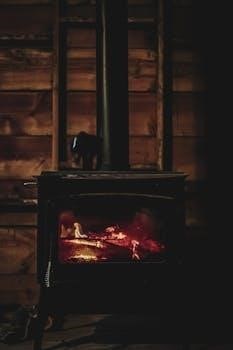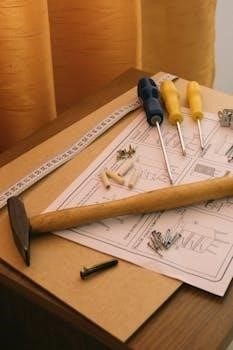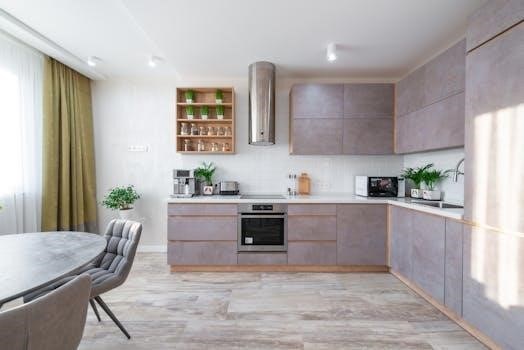
wood stove instructions
Wood Stove Installation⁚ A Comprehensive Guide
Proper wood stove installation is critical for safety, preventing fire hazards and smoke damage. This guide, referencing NFPA standards, offers tips for safe residential installation. Ensure adequate clearances from combustibles and proper chimney capacity for a secure setup.
Pre-Installation Considerations
Before installing a wood stove, several crucial factors must be assessed. Firstly, determine the type of fireplace and chimney you currently have. If you possess a masonry fireplace and chimney, your options are generally more flexible. However, if you have a metal (zero clearance) fireplace and chimney, your choices are often limited. Only specific inserts are tested for use with prefabricated fireplaces and chimneys, therefore, it is imperative to consult with a local hearth retailer and verify the compatibility in the installation manual or manufacturer’s literature, avoiding any modifications. The stove size should be appropriate for the space, considering both the available area and necessary clearances around the stove, as well as the fuel size being used. These steps ensure a safe and efficient installation, setting the foundation for proper performance.

Choosing the Right Location
Selecting the appropriate location for your wood stove is paramount for safety and efficiency. This process should be completed before moving the stove, as it’s often a heavy and cumbersome piece of equipment. The stove’s placement significantly impacts its performance and the overall safety of your home. Consider the proximity to combustible materials such as walls, floors, and furniture. Adequate clearance is essential to prevent fire hazards. The location must also allow for proper venting through a chimney system with adequate capacity, height and correct placement. A suitable location will also facilitate convenient access for fuel loading and maintenance, and will be in a area that maximizes heat distribution throughout the space. Ensure the chosen location can accommodate the weight and dimensions of the wood stove and that the area can be suitably protected with non-combustible materials.
Understanding Clearance Requirements
Clearance requirements for wood stoves are crucial for preventing fires, and they vary depending on the specific stove model and surrounding materials. These standards, typically based on National Fire Protection Association (NFPA) guidelines, dictate the minimum distance a stove must be from combustible surfaces like walls, floors, and furniture. For stoves on legs or pedestals, a minimum of 6 inches of ventilated space beneath the fire chamber is needed, usually using non-combustible materials such as closely spaced solid masonry bricks. The stove’s installation manual, along with local building codes, provides the specific clearance measurements for your stove. Always adhere to the more restrictive measurement. Adequate clearance not only mitigates the risk of fire but also ensures proper airflow around the stove, optimizing its heating efficiency. Failure to comply with these requirements can lead to a dangerous situation. Therefore, meticulous planning is essential.
Installation Steps
Installing a wood stove involves several key steps, beginning with choosing the correct location, and obtaining any required permits. The floor area needs proper protection using non-combustible materials like masonry bricks for stoves with legs or pedestals. Next, ensure the chimney system meets the requirements with the correct height and clearance from surrounding structures. Connecting the flue pipe to the stove and chimney, ensuring a tight and secure seal, is also needed. If your existing chimney is not up to the task, installing a stainless steel liner is essential for safe operation. Following these steps carefully is crucial for successful and safe wood stove installation. Always consult your stove’s manual and local regulations for specific guidance. A step by step guide is invaluable during this process. This careful approach will ensure the safe and effective operation of your new wood burning stove.
Preparing the Floor Protection
Proper floor protection is a critical step when installing a wood stove, guarding against heat transfer to combustible materials. For stoves with legs or pedestals providing at least 6 inches of ventilated space, use closely spaced solid masonry bricks or blocks that are at least 2 inches thick. The top surface should be covered with a non-combustible material. Ensure the floor protection extends beyond the stove’s footprint according to manufacturer specifications. This layer of protection prevents fire hazards. Incorrect floor protection is dangerous. The material you choose should be rated for high temperatures and provide adequate insulation. Confirm local codes and your stove’s manual for specific requirements. This meticulous preparation ensures your installation meets safety standards, thereby preventing potential fire risks. Remember, proper floor protection is not just recommended, it’s essential for safe wood stove operation.
Chimney System Requirements
A properly functioning chimney is vital for a safe wood stove installation, ensuring the safe removal of smoke and combustion byproducts. The chimney must have adequate capacity, the correct height, and proper location to function correctly. It should extend a minimum of 3 feet above the roof and be 2 feet higher than any structure within 10 feet. A chimney sweep should inspect the chimney interior for cracks or missing mortar. If the existing chimney is not safe or correctly sized, a stainless steel liner is likely required. This liner provides a safe and correctly sized flue for the stove. The chimney system is not optional. Choosing the wrong system or an unsafe chimney can lead to disaster. Never underestimate the importance of proper chimney installation.
Flue Pipe Connection
Connecting the flue pipe correctly to your wood stove and chimney is crucial for a safe and efficient system. The flue pipe serves as the conduit for smoke and gases to travel from the stove to the chimney. Always ensure that the pipe is the correct diameter and is made of a material suitable for wood stoves, typically heavy-gauge steel. All connections must be secure, using the proper fasteners and techniques to prevent leaks. Improperly connected pipes can leak deadly carbon monoxide into your home. Follow the manufacturer’s guidelines for the correct installation and spacing. Never cut corners when connecting the flue pipe. The flue pipe connection must also maintain adequate clearance from combustible materials. Be sure to use the proper installation methods. A faulty flue connection can cause fires, so be cautious.

Installing a Stainless Steel Liner
Installing a stainless steel liner is often necessary when connecting a wood stove to an existing masonry chimney. This liner ensures the safe and efficient venting of combustion byproducts. If your chimney has cracked flue tiles or deteriorated mortar joints, a liner is essential. A stainless steel liner provides a smooth, continuous path for smoke, preventing creosote buildup and potential chimney fires. Choose a liner that is the correct diameter for your stove and chimney. The liner should be installed from the top of the chimney down, and it must be fully insulated to maintain proper draft and reduce condensation. Secure the liner at both the top and the bottom, following the manufacturer’s instructions. A professional chimney sweep can inspect and advise on the need for a liner, ensuring compliance with safety standards. The liner is key to a safe heating system.

Safety and Post-Installation
Following installation, safety should be the primary concern. Before the first fire, conduct a thorough inspection to ensure all connections are secure and clearances are maintained. Verify that the stove is placed on a non-combustible base with proper floor protection. The chimney system must be clear and appropriately sized. Pay close attention to carbon monoxide safety by installing a detector. The first few fires should be small to allow the stove to break in gradually, and you should also monitor its performance. Always have a fire extinguisher nearby. Ensure proper ventilation in the room. It’s essential to familiarize yourself with the stove’s operating manual. Regular visual checks of your installation will help identify any potential problems. Never leave a burning stove unattended and keep combustible materials a safe distance away. The safety of your family depends on consistent and careful operation.
First Firing and Break-in Period

The initial firing of your new wood stove is a crucial step and should be approached with care. Begin with a small fire, using only a few pieces of dry, seasoned wood. This allows the stove’s materials to expand and adjust to the heat gradually. Avoid a large, intense fire during the first few burns, as this can cause stress on the metal and lead to premature wear. The goal is to allow the stove to break in slowly, curing the paint and any internal components. During these first burns, you may notice some odors and smoke, which is normal. Make sure to open windows and provide proper ventilation. Monitor the stove’s temperature, ensure it doesn’t overheat, and check for any leaks. The break-in period also allows you to learn how your stove operates. This gradual process ensures the longevity and safety of your new heating appliance.
Importance of Regular Chimney Sweeping
Regular chimney sweeping is paramount for the safe and efficient operation of your wood stove. Creosote, a highly flammable byproduct of wood combustion, builds up inside the chimney flue over time. This accumulation poses a significant fire hazard, as creosote can ignite, leading to dangerous chimney fires. In addition, creosote buildup restricts airflow, reducing the stove’s efficiency and potentially causing smoke to back up into the living space. This can lead to carbon monoxide poisoning, a serious health risk. It is advisable to schedule a professional chimney sweep at least once a year, or more frequently if you use your stove often. A professional sweep can identify any potential issues, such as cracks in the flue tiles or mortar joints, ensuring your chimney is safe and well-maintained. Regular sweeping prevents hazards, maintaining the efficient and safe operation of your wood stove.
Carbon Monoxide Safety
Carbon monoxide (CO) is an odorless, colorless, and deadly gas produced by incomplete combustion, posing a significant risk with wood stoves. To ensure safety, install a carbon monoxide detector on each level of your home, especially near sleeping areas, and test them regularly. Ensure proper ventilation and never block the air intakes of your stove. A correctly installed flue system is essential for safely venting combustion gases. If you experience symptoms such as headaches, dizziness, or nausea, immediately evacuate your home and seek fresh air, as these could be signs of CO poisoning. Regular chimney sweeping is crucial, as creosote buildup can cause smoke to back up into your house, increasing CO exposure. Furthermore, ensure your stove is properly installed and maintained, as leaks in the stove or flue can cause dangerous CO levels. Prioritizing carbon monoxide safety is vital for protecting your family from this silent killer.
Permits and Inspections
Before installing a wood stove, obtaining the necessary permits is crucial, as they ensure compliance with local building codes and safety regulations. These permits vary by location and are often required for both the stove installation and chimney work. Check with your local building department to understand specific requirements, such as setback distances from walls and floor protection standards. An inspection by a certified professional is typically required after installation to verify that the setup meets safety guidelines. This inspection includes assessing proper clearances, chimney connections, and overall safety compliance. Failing to obtain permits and inspections can lead to penalties or insurance issues, and worse, it can compromise your safety. It’s also important to note that insurance companies may not cover damages or liabilities resulting from unpermitted installations. Therefore, always prioritize obtaining the required permits and scheduling the necessary inspections to protect yourself and your property. It is also important to ensure that the inspector has all the necessary documents and information about the stove being installed.